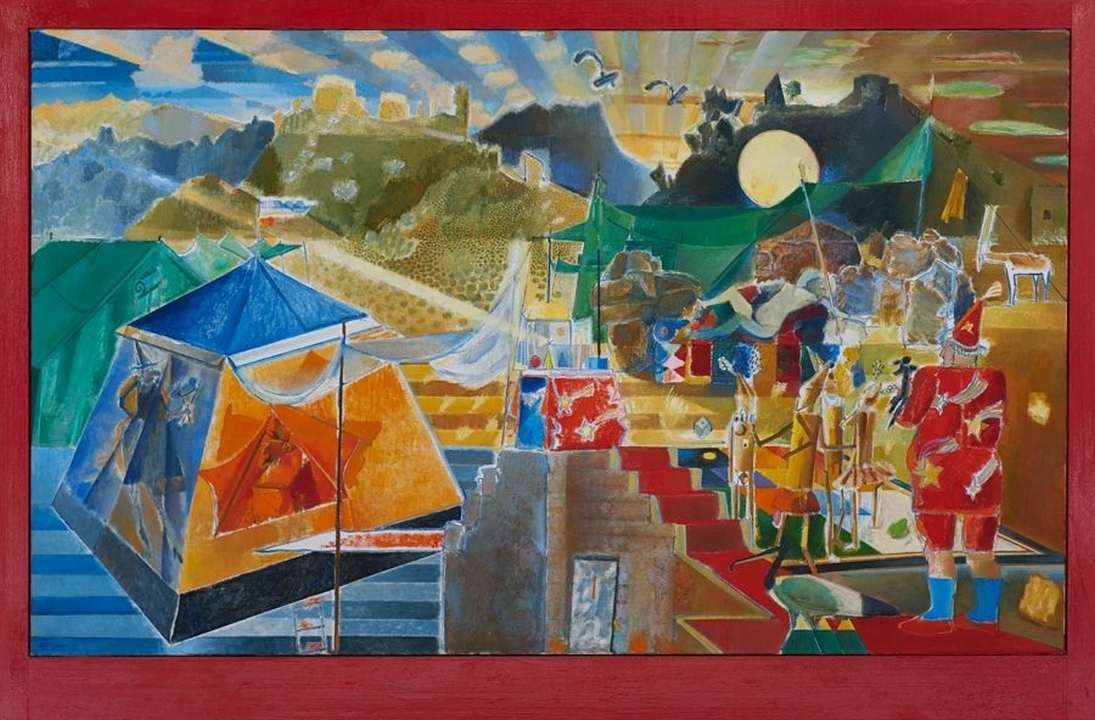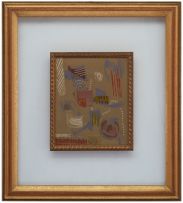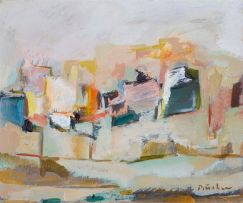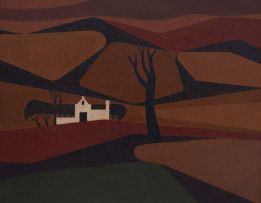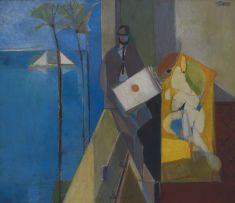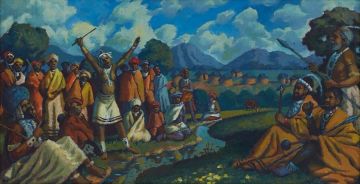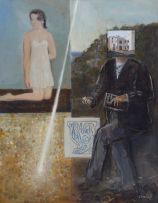Camping in the Kouebokkeveld
Stanley Pinker
Incl. Buyer's Premium & VAT
About this Item
signed
Notes
Stanley Pinker's Camping in the Kouebokkeveld is an extraordinary painting that celebrates the ancient and modern artists who have drawn their inspiration from this are. It was painted in the same year and as a companion piece to Meeting at the Mountains of the Moon with which Pinker won the first prize and gold medal at the Cape Town Triennial in 1985. Described by Alan Crump, former Professor and Head of the Department of Fine Arts at the University of the Witwatersrand and Chair of the National Arts Festival Committee, as the largest exhibition of its kind to travel to major centres in South Africa, it was sponsored by the Rembrandt van Rijn Art Foundation. Their handsome support entitled them to purchase the winning work which is housed in the Rupert Museum in Stellenbosch, where it is currently on display. In Crump's opinion, "the prize-winning work by Stanley Pinker undoubtedly marks a high point in his distinguished career as a painter".1
Like Meeting at the Mountains of the Moon which, according to the artist, was based on a real event while camping in Namibia with a group of friends,2 Camping in the Kouebokkeveld documents an actual expedition, in this case, to the mountain area of the Western Cape located around Prince Alfred Hamlet, to the north of Ceres and south east of Citrusdal.
This was one of the favourite destinations of a group of artists who made regular trips to sketch and paint, to experience and to be inspired by the great outdoors, that quintessentially South African pursuit. Amongst the group were several artists such as Erik Laubscher, some of whose most impressive paintings were inspired by his experiences in this area.
A spectacular sun rises over the distinctive silhouette of the Sneeuberg mountains while a full moon hangs low in the valley, as in Meeting at the Mountains of the Moon. As if in a Medieval scene, a wizard and a witch, who appear to be conjuring their magic, disport themselves in a square Regent Pavilion tent topped with a torn South African flag of the old dispensation, heralding its demise. The couple represent Roddy and Hermine Wengrowe, who have been described as the stable core around which an extraordinary circle of creative artists spun. In fact, so central a role did they play that it was on Roddy Wengrowe that the Pinker family bestowed the honour of Master of Ceremonies at the artist's memorial at Hiddingh Hall. And it is to the Wengrowes that we are indebted for the narratives that form the content of the painting.
Erik Laubscher was the acknowledged pioneer, who found wonderful places to explore and to set up camp. In the middle distance at left and right, the green tents, perhaps alluding to fecund creativity, were inhabited by artists and their families. Famous couple, Erik and his French-born wife, Claude Bouscharain, occupied one while the son and daughter-in-law of Austrian-born artist, Alfred Krenz, camped alongside.
Art and design educator, Mel Hagen, languidly offers her body to the sun like a reclining muse. Marthinus la Grange, remembered as a gifted draughtsman and drawing teacher, appears as a magician, directing activities that include a group of San dancers costumed for a performance. These may well be inspired by the San rock paintings found nearby. The Krenzes confirm that Pinker and his fellow campers were well-acquainted with these paintings,3 some of which, portraying Voortrekker wagons, are conceivably the earliest visual representations of contacts between indigenous peoples and European settlers.
Pinker's thorough understanding of the formalist achievements of Modernism, gained first-hand during his decade-long sojourn in Europe in the 50s and 60s, is put to effective use in this painting. The dynamism of the composition, emphasised through radiating lines that extend into dramatic diagonals, binds all the artists together into a centre that erupts with sensuous colour. Striped patterning - a playful reference to artists like Jasper Johns - reinforces the flatness of the canvas, providing a rigorous structure overlaid with three-dimensional elements that attest to Pinker's fine observation in capturing the characteristic topography and fauna of this unique place.
1. Crump, Alan. (1985) Cape Town Triennial 1985, Cape Town: South African National Gallery, unpaginated.
2. Stevenson, Michael and Pinker, Stanley. (2004) Stanley Pinker. Cape Town: Michael Stevenson, page 70.
3. Confirmed by André Krenz in conversation with Emma Bedford, 13 May 2014.
Provenance
Acquired directly from the artist by the current owner
